“Guinan: I’ll see you in 500 years, Picard.
Picard: And I’ll see you… in a few minutes.”
– from Time’s Arrow, Part II, Star Trek: The Next Generation
Sometimes I get a little carried away with the history based themes. Not often, I mean, I do pick oddities out of history, but generally I don’t delve deeply into history. Way back in the early years of the Second Sunday Supper Circle, for our February 1997 dinner, I did put together a six-course menu where I went back 600 years in history to 1397, 1497, 1597, 1697, 1797 and 1897 and picked a particularly notable event in each of the art, literature and political worlds, and then came up with a dish tied to all three, century by century. But I gave myself the entire year to pick things from. Usually this sort of dumpster diving occurs on really grey, rainy days when I don’t feel like firing up an online game like Rift or WoW or EQ… and instead just start surfing the web. So this weekend, I went back 500 years in time, but, I limited the inspirational events to things that happened on either July 29th or 30th in those past five centuries….
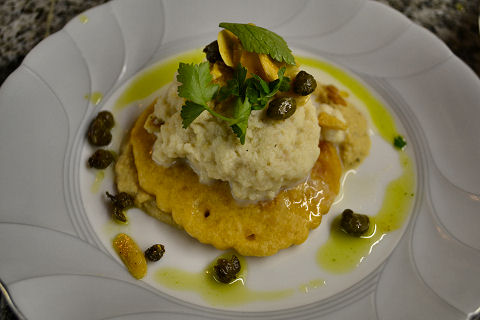
On July 30, 1511, Giorgio Vasari was born in Arezzo, Italy. He went on to become a quite famed artist and architect, but he is perhaps best known for having written the 1550 tome The Lives of the Most Excellent Painters, Sculptors and Architects at the request of Cardinal Farnese. A quote which seems to hover around this book, I think from the dedication of the book to Grand Duke Cosimo de’ Medici, though that’s not clear, would actually be a fun quote for this dinner: “One day someone will write a treatise on those dinner parties whose fortunate conjunction of guests and ideas has changed the course of civilisation.”
A classic dish from Arezzo is the Baccalà all’Aretina – a dish of reconstituted salt cod (likely the only saltwater fish regularly available in the area at the time) that was coated with a crust of almonds, garlic, anchovies, parsley and capers, baked, and served over a chickpea or other bean stew. Here, a puree of chickpeas, anchovies, smoked pepper and olive oil, topped with a chickpea and almond flour pancake. On top of that, a relatively classic brandade, Ligurian style (a bit north of Arezzo, but so be it), made with fresh cod poached in cream, garlic, thyme and bay leaf, then whipped with green lemon olive oil, salt and white pepper. Atop that, sauteed almonds and capers and a final garnish of parsley, along with a drizzle of parsley oil around the plate.
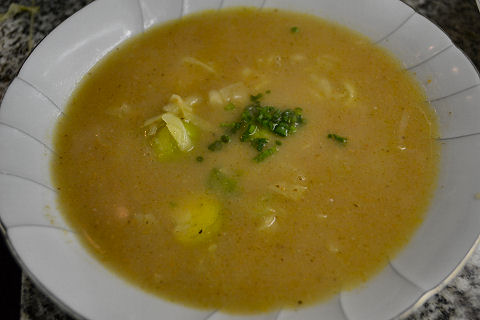
In the early 1600s, piracy on the high seas was the order of the day and a particular problem for the Portuguese fleet, much of the piracy occurring near to (and based out of) the Azores – and in complicity with the local government and military. On July 30, 1611, King Phillip II of Portugal issued a call for the capture of Pirate Admiral Peter Easton, who commanded a fleet of 40 pirate ships. Though he was never captured, the islands were, and the local conspirators taken into custody.
Much of the food of the Azores is based on Portuguese roots, and a local soup, Sopa de Couves is a take on the classic Portuguese Caldo Verde. It’s a soup that has as many variations as there are cooks, with a base of, generally, potatoes, and the addition of either chorizo or ham hocks, possibly beans, plus some sort of greens – kale or collards being the most common. Heading a bit different direction I set out to make a chorizo consomme as the base, planning to add a mix of greens to it, or perhaps some greens filled dumplings. I didn’t like the way the consomme turned out in my experiments and decided in the end to make more of a bisque style soup of roasted cauliflower and sauteed cured chorizos, along with onions and garlic. Into that, blanched and sauteed green cabbage and brussels sprouts. A nice, hearty cold weather soup without the stodginess of the potatoes or beans.
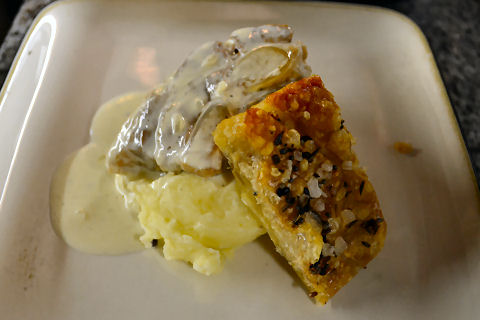
Claude-Adrien Nonnotte, born July 29, 1711 in Besançon, France, was a Jesuit priest who styled himself a bit of a philosopher. He wasn’t so good at coming up with his own philosophy, but was quite adept at lambasting others, and he set his sights on Voltaire for a wide array of criticism. Every time Voltaire published something, Nonnotte was sure to follow it up with his own publication refuting the tenets point by point with poignant sarcasm and insults. He also wrote several historical works, most notably a study of the comparison and contrast between ancient and modern philosophies.
From the area around Besançon comes a hearty dish called La Morbilette, essentially a layered torte of potatoes, onions, bacon and Morbier cheese, one of my favorites of the world of coagulated milk. Here, I braised pork breast in white wine, pork stock, red onions, garlic, bay, oregano, salt and black pepper until it was falling apart tender, about five hours. Served it up over mashed potatoes flavored with butter, olive oil, white pepper and nutmeg. The sauce, a classic Morbier sauce from the region – sweated chopped shallots in white wine until the liquid was absorbed, then added heavy cream and Morbier cheese, keeping it over very low heat just enough to melt the cheese and whisk it in – a little salt, white pepper and nutmeg to finish. The dish needed some texture to it, and what better than a crispy, crackly pork skin, rubbed with coarse salt and spices (Indian five spice blend as offered up by friend Ronica Sajnani – “equal parts of cumin seeds, fennel seeds, nigella seeds, fenugreek seeds and mustard seeds”), and into a high heat oven with the fan going for about 40-45 minutes until golden brown and a good amount of the fat rendered out – some stays, of course, that’s half the fun!
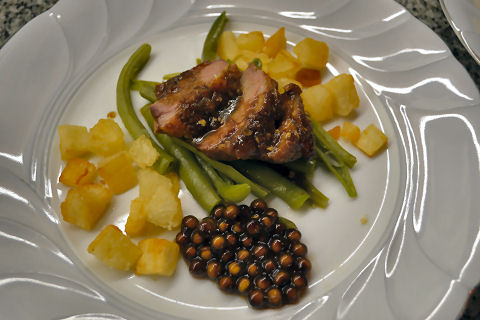
Moving to 1811 and July 30th, the date on which the Spanish executed Miguel Gregorio Antonio Ignacio Hidalgo y Costilla y Gallaga Mandarte Villaseñor, more commonly known as Manuel Hidalgo, a priest, and generally acknowledged as the leader of the Mexican revolution for independence and as the father of the nation. I’d actually thought about centering the whole dinner around him, but we have another Mexican theme coming up quickly that I opted for instead. Hidalgo was from Guanajuato, Mexico, which, while it of course has its traditional dishes, has recently become the center of a new, modernization movement in the culinary world, referred to as Guanajuato Fusion.
Since the fusion aspect has become central to many of the higher end restaurants in the area, I merely skimmed through a variety of menus and let myself get inspired by the local ingredients. Here we have a seared duck breast that was marinated in a mix of soy, honey, jalapeños and ají amarillos (the second night I left some slices of the chilies in the marinade to add some texture, the first night it was all pureed together as in this photo), then seared and finished in the oven to medium. Served over blanched and slivered green beans that were then tossed with a little olive oil, salt and pepper. Surrounding, fried cubes of yuca root and “duck caviar” – tapioca pearls cooked in duck stock (duck bones, celery, carrot, onion, shiitake mushrooms, salt and pepper).
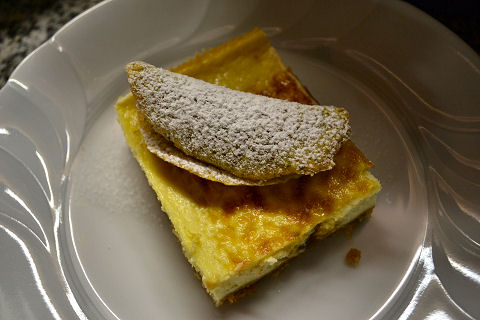
On July 29, 1911, Ján Cikker was born in Banská Bystrica, Slovakia. He went on to become one of the leading exponents of Slovakian classical music, winning various awards including a UNESCO prize for his work, in 1979.
From Slovakia in general, as I don’t know that there are any dishes, let alone desserts, that are specific to Banská Bystrica, there’s a very popular dish called Slivkove Gule, essentially dumplings made with a potato based dough wrapped around sugared plums and/or apricots, boiled up and then served covered with a ladle of fresh cottage or farmer’s cheese, melted butter and sugar, and sometimes, additionally, sour cream! And just to add on to it, at times, the dumplings, after being boiled are then coated in breadcrumbs and fried in butter. Amazingly enough, that’s not a dessert, but a main course served after soup. I went the dessert route, making one of our classic cheesecakes with homemade ricotta, swirled with both apricot and plum jams. Atop, a pistachio and almond tuile.
And that’s the way it was, 500, 400, 300, 200, and 100 years ago today, and our dinner celebrating key events from the last half-millenium.
[…] back a slow braised pork breast dish from a historical dinner last year. No real changes other than I couldn’t find any pork skin to crisp up, so went without it […]